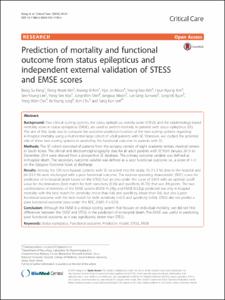Prediction of mortality and functional outcome from status epilepticus and independent external validation of STESS and EMSE scores
- Keimyung Author(s)
- Moon, Hye Jin; Cho, Yong Won
- Department
- Dept. of Neurology (신경과학)
- Journal Title
- Critical Care
- Issued Date
- 2016
- Volume
- 20
- Issue
- 25
- Keyword
- Status epilepticus; Functional outcome; Prediction model; STESS; EMSE
- Abstract
- Background: Two clinical scoring systems, the status epilepticus severity score (STESS) and the epidemiology-based
mortality score in status epilepticus (EMSE), are used to predict mortality in patients with status epilepticus (SE).
The aim of this study was to compare the outcome-prediction function of the two scoring systems regarding
in-hospital mortality using a multicenter large cohort of adult patients with SE. Moreover, we studied the potential
role of these two scoring systems in predicting the functional outcome in patients with SE.
Methods: The SE cohort consisted of patients from the epilepsy centers of eight academic tertiary medical centers
in South Korea. The clinical and electroencephalography data for all adult patients with SE from January 2013 to
December 2014 were derived from a prospective SE database. The primary outcome variable was defined as
in-hospital death. The secondary outcome variable was defined as a poor functional outcome, i.e., a score of 1–3
on the Glasgow Outcome Scale, at discharge.
Results: Among the 120 non-hypoxic patients with SE recruited into the study, 16 (13.3 %) died in the hospital and
64 (53.3 %) were discharged with a poor functional outcome. The receiver-operating characteristic (ROC) curve for
prediction of in-hospital death based on the STESS had an area under the curve of 0.673 with an optimal cutoff
value for discrimination (best match for both sensitivity (0.56) and specificity (0.70)) that was ≥4 points. The two
combinations of elements of the EMSE system (EMSE-ALDEg and EMSE-ECLEg) predicted not only in-hospital
mortality with the best match for sensitivity (more than 0.6) and specificity (more than 0.6), but also a poor
functional outcome with the best match for both sensitivity (>0.7) and specificity (>0.6). STESS did not predict a
poor functional outcome (area under the ROC, 0.581; P = 0.23).
Conclusion: Although the EMSE is a clinical scoring system that focuses on individual mortality, we did not find
differences between the EMSE and STESS in the prediction of in-hospital death. The EMSE was useful in predicting
poor functional outcome, as it was significantly better than STESS.
- Publisher
- School of Medicine
- Citation
- Bong Su Kang et al. (2016). Prediction of mortality and functional outcome from status epilepticus and independent external validation of STESS and EMSE scores. Critical Care, 20(25), 1–8. doi: 10.1186/s13054-016-1190-z
- Type
- Article
- ISSN
- 1364-8535
- Appears in Collections:
- 1. School of Medicine (의과대학) > Dept. of Neurology (신경과학)
- 파일 목록
-
-
Download
 oak-2016-0183.pdf
기타 데이터 / 983.43 kB / Adobe PDF
oak-2016-0183.pdf
기타 데이터 / 983.43 kB / Adobe PDF
-
Items in Repository are protected by copyright, with all rights reserved, unless otherwise indicated.